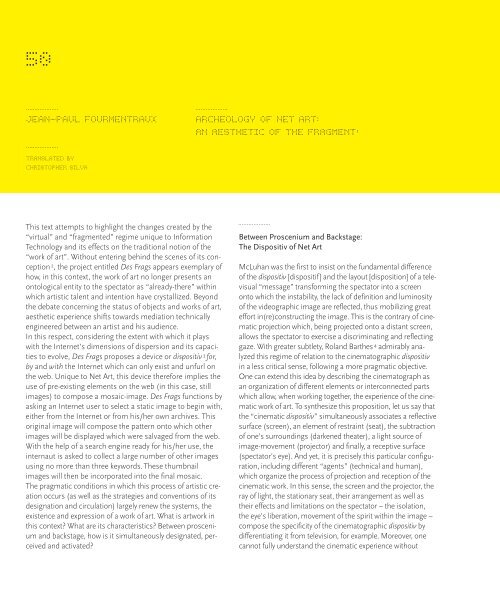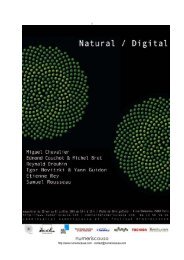Télécharger le pdf de la publication - Reynald Drouhin
Télécharger le pdf de la publication - Reynald Drouhin
Télécharger le pdf de la publication - Reynald Drouhin
Create successful ePaper yourself
Turn your PDF publications into a flip-book with our unique Google optimized e-Paper software.
50<br />
...................<br />
JEAN-PAUL FOURMENTRAUX<br />
...................<br />
TRANSLATED BY<br />
CHRISTOPHER SILVA<br />
This text attempts to highlight the changes created by the<br />
“virtual” and “fragmented” regime unique to Information<br />
Technology and its effects on the traditional notion of the<br />
“work of art”. Without entering behind the scenes of its conception<br />
2 , the project entit<strong>le</strong>d Des Frags appears exemp<strong>la</strong>ry of<br />
how, in this context, the work of art no longer presents an<br />
ontological entity to the spectator as “already-there” within<br />
which artistic ta<strong>le</strong>nt and intention have crystallized. Beyond<br />
the <strong>de</strong>bate concerning the status of objects and works of art,<br />
aesthetic experience shifts towards mediation technically<br />
engineered between an artist and his audience.<br />
In this respect, consi<strong>de</strong>ring the extent with which it p<strong>la</strong>ys<br />
with the Internet’s dimensions of dispersion and its capacities<br />
to evolve, Des Frags proposes a <strong>de</strong>vice or dispositiv 3 for,<br />
by and with the Internet which can only exist and unfurl on<br />
the web. Unique to Net Art, this <strong>de</strong>vice therefore implies the<br />
use of pre-existing e<strong>le</strong>ments on the web (in this case, still<br />
images) to compose a mosaic-image. Des Frags functions by<br />
asking an Internet user to se<strong>le</strong>ct a static image to begin with,<br />
either from the Internet or from his/her own archives. This<br />
original image will compose the pattern onto which other<br />
images will be disp<strong>la</strong>yed which were salvaged from the web.<br />
With the help of a search engine ready for his/her use, the<br />
internaut is asked to col<strong>le</strong>ct a <strong>la</strong>rge number of other images<br />
using no more than three keywords. These thumbnail<br />
images will then be incorporated into the final mosaic.<br />
The pragmatic conditions in which this process of artistic creation<br />
occurs (as well as the strategies and conventions of its<br />
<strong>de</strong>signation and circu<strong>la</strong>tion) <strong>la</strong>rgely renew the systems, the<br />
existence and expression of a work of art. What is artwork in<br />
this context? What are its characteristics? Between proscenium<br />
and backstage, how is it simultaneously <strong>de</strong>signated, perceived<br />
and activated?<br />
...................<br />
ARCHEOLOGY OF NET ART:<br />
AN AESTHETIC OF THE FRAGMENT1 ...................<br />
Between Proscenium and Backstage:<br />
The Dispositiv of Net Art<br />
McLuhan was the first to insist on the fundamental difference<br />
of the dispositiv [dispositif] and the <strong>la</strong>yout [disposition] of a te<strong>le</strong>visual<br />
“message” transforming the spectator into a screen<br />
onto which the instability, the <strong>la</strong>ck of <strong>de</strong>finition and luminosity<br />
of the vi<strong>de</strong>ographic image are ref<strong>le</strong>cted, thus mobilizing great<br />
effort in(re)constructing the image. This is the contrary of cinematic<br />
projection which, being projected onto a distant screen,<br />
allows the spectator to exercise a discriminating and ref<strong>le</strong>cting<br />
gaze. With greater subt<strong>le</strong>ty, Ro<strong>la</strong>nd Barthes 4 admirably analyzed<br />
this regime of re<strong>la</strong>tion to the cinematographic dispositiv<br />
in a <strong>le</strong>ss critical sense, following a more pragmatic objective.<br />
One can extend this i<strong>de</strong>a by <strong>de</strong>scribing the cinematograph as<br />
an organization of different e<strong>le</strong>ments or interconnected parts<br />
which allow, when working together, the experience of the cinematic<br />
work of art. To synthesize this proposition, <strong>le</strong>t us say that<br />
the “cinematic dispositiv” simultaneously associates a ref<strong>le</strong>ctive<br />
surface (screen), an e<strong>le</strong>ment of restraint (seat), the subtraction<br />
of one’s surroundings (darkened theater), a light source of<br />
image-movement (projector) and finally, a receptive surface<br />
(spectator’s eye). And yet, it is precisely this particu<strong>la</strong>r configuration,<br />
including different “agents” (technical and human),<br />
which organize the process of projection and reception of the<br />
cinematic work. In this sense, the screen and the projector, the<br />
ray of light, the stationary seat, their arrangement as well as<br />
their effects and limitations on the spectator – the iso<strong>la</strong>tion,<br />
the eye’s liberation, movement of the spirit within the image –<br />
compose the specificity of the cinematographic dispositiv by<br />
differentiating it from te<strong>le</strong>vision, for examp<strong>le</strong>. Moreover, one<br />
cannot fully un<strong>de</strong>rstand the cinematic experience without






